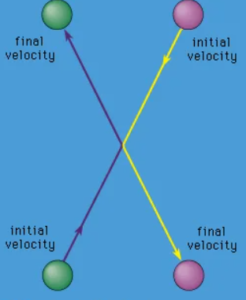Table of Contents
A collision between two bodies can always be described in terms of total momentum being zero. This is the previously mentioned centre-of-mass (or centre-of-momentum) frame. Then, as shown in Figure, in the collision between two bodies of the same mass, the two bodies always have equal and opposite velocities. It should be noted that the outgoing momenta in this frame of reference are antiparallel rather than perpendicular.

As a relative, any two objects can be compared based on their distinct characteristics. Relative motion can be defined as comparing one object’s motion to that of another object moving at the same velocity. One can easily determine relative motion by using relative velocity, relative acceleration, or relative speed. The object is in a static state as long as its relative motion to the earth is constant.
The concept of relative motion refers to the comparison of the relative accelerations and velocities of two rigid bodies. It is simple to state that any two objects’ motion can be compared as relative motion. The relative motion of one object in relation to another is referred to as its reference frame. When an object, such as a train, is compared to the earth, its relative motion can be calculated.
Thus, in this example, a train is moving at a specific relative speed to Earth (which is our reference frame). When it comes to relative motion, reference frames are extremely important because relative motion is calculated using reference frames. We can use the motion of the earth around the sun as an example of a larger frame of reference, with the solar system serving as the reference frame for the earth’s motion around the sun.
Relative Motion in One Dimension
Objects move in a straight line in one-dimensional motion. As a result, there are only two possibilities: All of the objects are moving in the same direction.
Objects are moving in the inverse direction. Consider the case of a man sitting on a train that is moving at 100 km/hr forward. The trees outside are then moving backwards at 100 km/hr, according to the man on the train. Because, from a man’s perspective, the outside environment is moving in the opposite direction as the train at the same speed. So, for all types of questions, if you need to find A’s velocity with respect to B, assume B is at rest and give A-B’s velocity.
Relative Motion in Two Dimensions
The same principle will apply in two-dimensional motion. If you need to find A’s velocity with respect to B, assume B is at rest and give A-B’s velocity in the opposite direction. Consider two objects A and B that are moving with velocities Va and Vb in relation to some common frame of reference, such as the ground or the earth. We need to find A’s velocity with respect to B, so assume B is at rest and give A-B’s velocity in the opposite direction.
Vab = va – vb
Similarly, to calculate the velocity of object B with respect to A, assume A is at rest and multiply the velocity of A by the velocity of B.
Vba = vb – va
Also read: Paramagnetic Materials
FAQs:
What does it mean to say that motion is relative?
It means that any object's motion is described in relation to the motion of the Earth. It means that the motion of one object is described in relation to the motion of another. It means that motion is unaffected by the frame of reference.
What exactly is relative motion law?
The physical laws that apply when you are at rest on the earth also apply when you are in any reference frame that is moving at a constant velocity with respect to the earth. For example, if the motion is in a straight line at a constant speed, you can toss and catch a ball in a moving bus.






